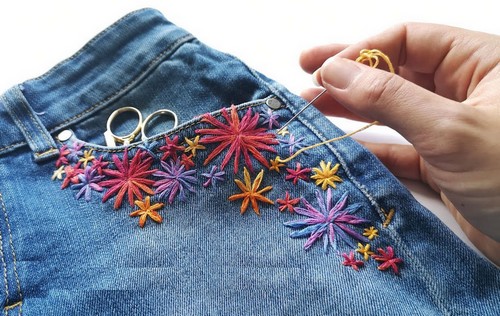Ebroidery

A Look Back: Embroidery’s History
The ancient art of embroidery goes back thousands of years. Chinese, Egyptian, and Indian civilizations used to adorn their clothes and other fabrics with the help of needles and threads. Initially used to reinforce clothes, embroidery now serves as a way to beautify and improve the fashion aspect. It was used for the attire of priests, kings, and queens in medieval Europe. It indicated wealth, status, and power. Each nation brought a different style to embroidery, hence so many styles to choose from nowadays.
The Importance of Embroidery
There is something more to embroidery than its mere decoration. Embroidery tells stories and expresses a person’s emotions, culture, and religion. Embroidery is employed during festivals, weddings, and other events in most countries. Embroidered saris are used for weddings in India, for example. The designs often symbolize happiness or prosperity. “Sashiko” is a technique employed in Japan to make clothes appear beautiful and last longer. Besides that, embroidery is passed from one generation to the next. The grandmothers teach grandchildren, and the mothers teach daughters. This maintains family traditions. Embroidery is now utilized in modern fashion and home furnishing, apart from traditional apparel. It makes all things distinctive and handmade-looking.
The Creation of Embroidery
Simple or complex embroidery can be done. The process begins with choosing a cloth. Then a pattern is drawn or sketched on the fabric. An embroidery hoop is a circular wooden or plastic ring employed to keep the fabric tight while sewing. The type of stitch is then determined by the person engaged in needlework. French knot, satin stitch, chain stitch, and backstitch are some of the common stitches. Each stitch creates an individual texture and look. Time-consuming as it is, hand embroidery can create a very individualized look. While time is taken, machines that work faster and in factories to do mass production are also able to finish the work. Nevertheless, the elegance and personal touch of hand embroidery have never faded from popularity.
Types of Embroidery and Materials Used
Fabric, threads, needles, and sometimes other adornments such as beads, sequins, or mirrors are the minimum materials required for embroidery. The fabric can be synthetic, cotton, silk, or linen. The thread is available in a range of colors and is usually made of cotton, silk, or wool. The fabric type and thickness of the thread are considered while choosing needles.
Embroidery exists in the form of countless styles from all across the world. Some of the most common ones include:
- Phulkari: Colorful and lively floral patterns that are commonly seen on dupattas and shawls in Punjab, India.
- Light and airy white stitching, usually done on cotton or muslin, is referred to as chikankari (Lucknow, India).
- Nature-inspired, Kashida (Kashmir, India) has soft woolen threads embroidered with pictures of birds, flowers, and trees.
- Zardozi in India is a regal style made with silver and gold threads, sometimes studded with stones and pearls. It was a favorite of kings and queens.
- Kantha (West Bengal, India): Typically made of vintage saris, this type has plain running threads that create beautiful patterns.
- With wool thread on linen, crewel (England) often includes large floral motifs.
- Sashiko in Japan is white thread applied over indigo cloth to stiffen clothes and lengthen their wear.
- Hardanger (Norway): Geometric pattern involving cutting, folding, and stitching.
Each type has a distinctive look and cultural basis.
Conclusion: Every Stitch Has Magic
Embroidery is a way of showing love, heritage, and creativity, as well as being a method of decorating fabric. It passes down stories from generation to generation and connects us with the past. Machines can’t fully substitute for the special touch that needlework provides, whether it’s a beautifully embroidered dress or a lovingly stitched gift from someone dear to you. Embroidery is becoming popular again as more people around the globe look for sustainable and handmade clothing. It makes us slow down and appreciate the time and effort that goes into every stitch. Every piece of needlework speaks about an individual, a place, and a cause.